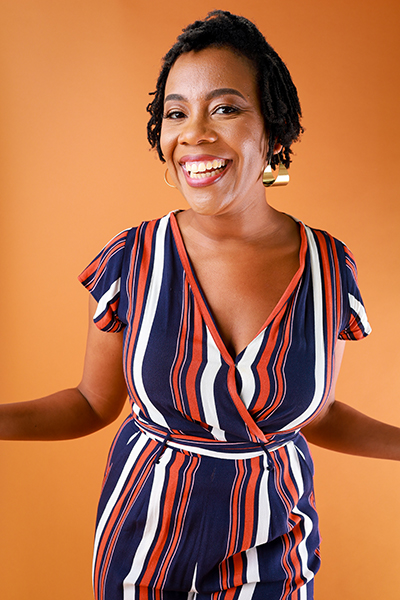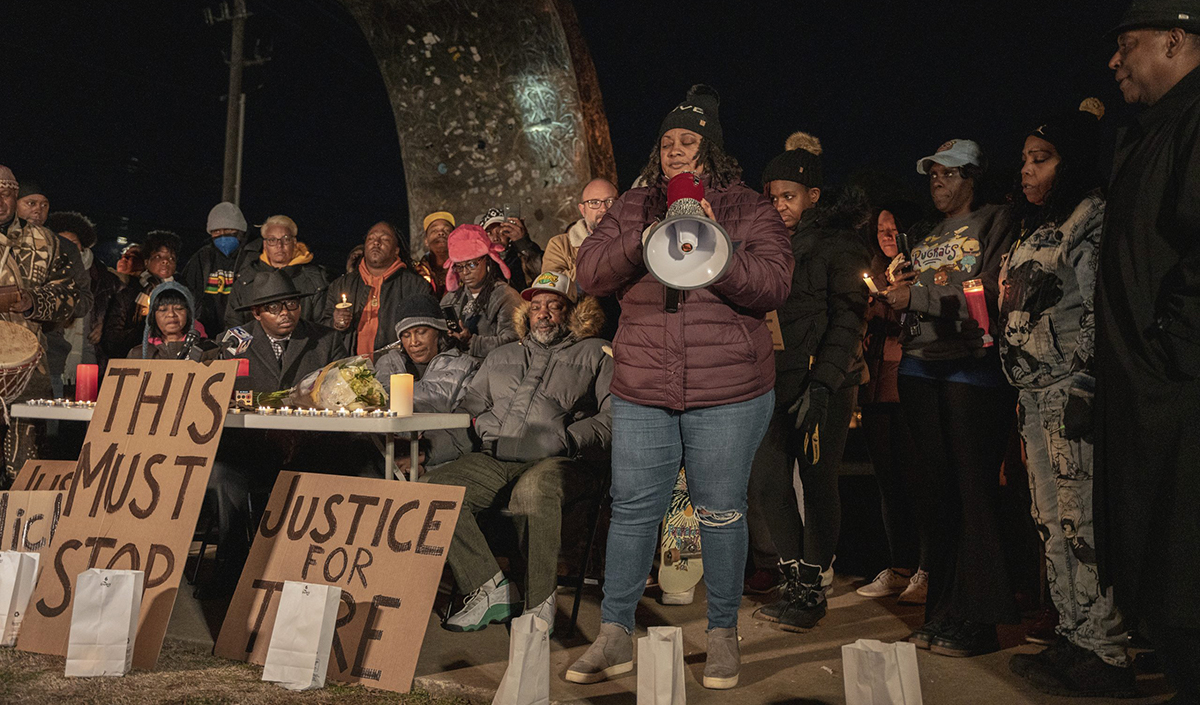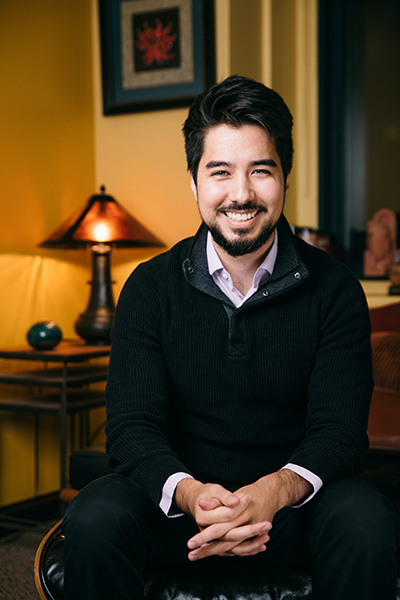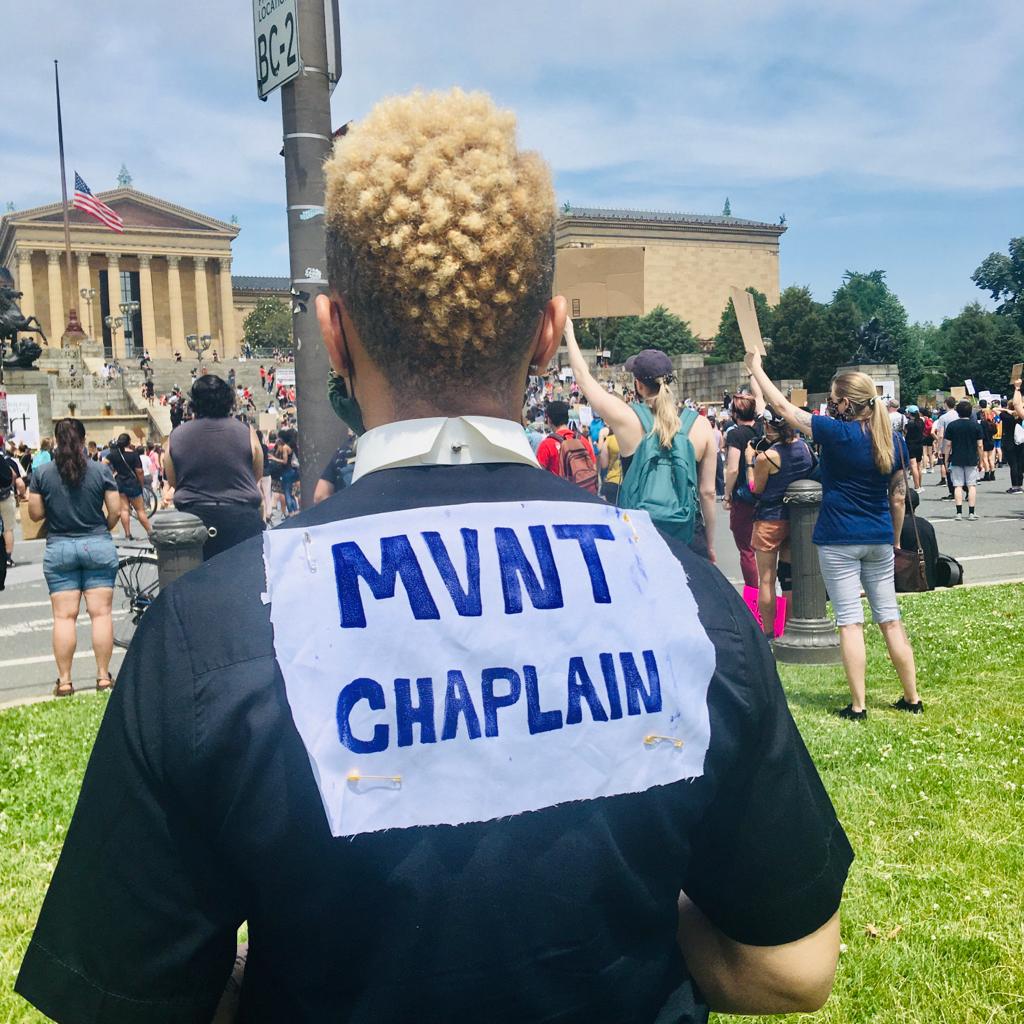Teresa Mateus got the call from Charlottesville, Virginia, on the August 2017 day when a white supremacist drove his car into a group of counterprotesters, killing Heather Heyer and injuring dozens of others.
Organizers there asked, “Can you come?”
“They were inundated with all of this trauma,” Mateus said. “And even the providers in the community that had treated trauma for years didn’t know how to treat this kind of trauma, because it was unique and new and specific to social movements.”
Mateus, based in Louisville, Kentucky, is a licensed clinical social worker and trauma therapist by training who teaches spiritual care. And she offers such care for those involved in social movements. The work has history, and world events in recent years have given it renewed urgency.
“The lineage of healing justice going back to at least the ’80s is really the genesis for the kind of work that we’re talking about when we’re talking about doing healing work — spiritual care and social movements,” Mateus said.
Issues like racial justice, women’s rights and the environment have pushed people into the streets and their concerns onto computer screens, televisions and newspaper pages, reaching beyond those actively engaged in protests. Between Jan. 20, 2017, and Jan. 31, 2021, the Count Love project (which tracks public protests through local media coverage) reported 27,270 U.S. protests, with more than 13.6 million attendees.
These protests, and the ongoing activism that happens in less public settings, can be emotional for participants as well as those observing them or living in affected communities. Movement chaplains can help address the distress, sadness and exhaustion that may accompany activism.

“We believe the field of chaplaincy has expanded tremendously. We believe that the way we are called to provide spiritual care is different in 2023; therefore, we believe that movement chaplaincy is the most cutting-edge way of doing chaplaincy in 2023,” said the Rev. Dr. Danielle J. Buhuro, the director of movement chaplaincy for Faith Matters Network. The Nashville-based nonprofit offers resources for connection, spiritual sustainability and accompaniment for community organizers, faith leaders and activists.
“People who are involved in movement chaplaincy take seriously this notion that we are called to care not only for the spiritual, religious or faith needs of a person, but we are called to care also for the social and emotional mental health of patients,” said Buhuro, who is also the executive director of Sankofa CPE Center.
The evolution of movement chaplaincy
How is your faith community present or absent in movements for justice? Why is that?

The Rev. Jen Bailey, the founder and executive director of Faith Matters Network, wrote in an email interview that movement chaplaincy is only one manifestation of work in social movement spaces that centers healing and care.
Movement chaplains offer spiritual, emotional and relational support to people engaged in social justice movements, wherever these people may be. Their work “has its antecedents in the lineage of the Southern Freedom Movement and more contemporary efforts through the healing justice movement,” Bailey wrote.
Mateus also pointed to the “heavy history” of healing justice in the Detroit area. “It’s very important work; it was happening very grassroots,” she said, noting that although the work wasn’t situated in what are considered epicenters of power, “luckily, it’s beginning to rise to the top.”
There is breadth in how the efforts are framed. For instance, the person offering the chaplaincy can be grounded in movement culture and understand activist life and what it’s like to be an organizer, said Hilary Allen, who previously consulted on the movement chaplaincy project at FMN.
Under this definition, the approach that chaplains take is intended to be anti-oppressive, to fit within movement culture, and the person or organization receiving the care also is “grounded in movement,” she said. In this way, the presence of chaplains allows there to be spiritual care in secular spaces.
At the height of 2020’s protests — in the midst of the COVID-19 pandemic and the aftermath of the brutal slayings of Ahmaud Arbery, Breonna Taylor, George Floyd and others — images showed seas of people demonstrating in cities across the country. Related images showed law enforcement officers dressed in riot gear, using tear gas, brandishing batons and pushing back against the crowds — even as almost 95% of U.S. demonstrations during that time connected to the Black Lives Matter movement were peaceful.
Activists continue their work amid the seemingly infinite unfolding of more tragedy, such as the January 2023 killing of Tyre Nichols by police officers in Memphis, and the subsequent release of deeply disturbing videos.
The Rev. Vahisha Hasan, who is based in Memphis as a part of the activist community, is dedicated to providing this kind of pastoral care. After Nichols was killed, his community of fellow skateboarders organized a vigil at a local skateboarding park. There, standing under the night sky surrounded by a crowd, Hasan offered the opening prayer.
What justice issues are people concerned with in your area, and how are faith communities part of the concern? How might they be part of the solution?

She has attended meetings with the district attorney and the Department of Justice, she said, and attended Nichols’ nationally streamed funeral.
Hasan has focused on faith, social justice and mental health as program director at Historic Clayborn Temple in Memphis (the site where activists organized for the 1968 sanitation workers strike) and as executive director for Movement in Faith, a project of the Transform Network that works, in part, to connect people and faith communities with broader justice efforts to practice transformational church and social change.
“In order to do sustainable movement work, we need to have integrated wellness. How do we do this — how do we live and not die? We don’t want the state to take our life. But we don’t want this work to take our life either,” Hasan said. “The overarching framework of my theory of change, if you will, is that we need well people who are doing well work to create well systems.”
In many ways, Hasan is typical of those carrying this work forward.
“Many of the folks who seem most drawn to movement chaplaincy,” wrote FMN's Bailey, “are those who feel a particular call to accompany those on the frontlines of social justice issues and/or who have some training in pastoral care, mental health, etc., and are looking for ways to deploy their skills in a way that can be nourishing to movement spaces.”
Movement chaplaincy also seems to be growing more common. “We believe that the tide is turning,” said Buhuro, the chaplaincy director. “We see more people working in various forms of social justice chaplaincy than we do folks working in the hospital. … We believe the hospital chaplaincy is no longer the traditional model.”
Accessing training
Training for this demanding vocation is offered by groups such as Faith Matters Network and PeoplesHub. At FMN, students are offered “the opportunity to dig deep into their own traditions of healing and accompaniment while also learning practical skills for de-escalation and mental health first aid that can be of assistance to organizers and activists,” wrote executive director Bailey.
The network’s 12-week course, offered in partnership with the School of Global Citizenry, launched in 2019 and has trained more than 600 participants so far, according to Bailey.
“Students who took the 2022 course were involved in multiple capacities with local, national, and international movements for justice as well as serving as leaders in social justice work in their congregations. The course equipped students to draw from their particular denomination’s spiritual practices as a source for their approach to movement chaplaincy,” she wrote.
Participants have gone on to engage with everything from discipleship groups to social justice committees to anti-racism teams in churches from California to Maryland. Some have also continued to work independently of churches.
“Especially with the training course, we found that a lot of people were interested in movement chaplaincy as a sort of additional skill set or tool set that they’d be able to rely on,” said Allen, the former network consultant. That broad subset of trainees could include people such as social workers, emergency medical workers, attorneys and even teachers, she said.
Mateus, the social worker and teacher, said there are many stages of social movements and many stages of trauma within them.
“I believe there’s a place for chaplaincy and spiritual care at every layer,” she said.
At the time she received the call to Charlottesville, the city already had some resources and infrastructure, Mateus said. When she got to the scene about a day and a half later with a small team, she connected with Unitarian Universalist organizers who had been previous contacts, along with Black Lives Matter leadership, to find a location and hold space for people who needed support. Through word of mouth, Signal chats and other community communications, they opened the space for drop-in hours to allow people to visit.
For her work providing spiritual care, Mateus said, she has integrated creative arts, contemplative practices such as yoga or meditation, and indigenous practices from her own Latinx orientation. She said this kind of care is especially important in communities of color, because there can be a lack of therapists who understand complex identities and the nuances of social movements.
Hasan incorporated breathwork into her prayer at the Memphis vigil. “Breathwork as a form of grounding has been really pivotal for me. And I include it in prayer; I include it as practice,” she said, noting that she also integrates as much communal healing as possible.
What is one creative way that you have offered or could offer support to justice advocates in your area?

When professionals are trained in movement chaplaincy, they can provide more well-rounded care in general. Kenji Kuramitsu, who is based in Chicago, is employed full time as a clinical social worker at an LGBTQ health care center, and part time as a chaplain to a nonprofit. Though his training in chaplaincy is more traditional (he formerly served in a hospital setting), he recognizes the benefits that movement chaplaincy can provide.
During the earlier days of the COVID-19 pandemic, he said, he volunteered as a chaplain to support front-line workers.
“Folks who were themselves ministry, spiritual care, congregational leaders or other kind of providers were feeling as exhausted, as terrified, as uncertain as the communities of people they were serving,” Kuramitsu said.
“Movement chaplaincy has the potential to provide access to spiritual care to populations that haven’t traditionally been served by chaplains,” he said.
Sustaining the work and connecting with communities
Movement chaplaincy can be a way to both reach people beyond church walls and offer those who would not ordinarily attend divinity school a way to care spiritually for others.

“As we know, some people, for whatever reason, it’s their life circumstance, are never going to quite get close enough to those faith communities to be able to access those resources,” Allen said. “Movement chaplaincy may be something that a person could get from a pastor, but they may never step foot inside a church.”
For faith leaders who want to participate in this chaplaincy or help sustain it, Mateus said, understanding the fluidity of these practices can be helpful. Many of those in movements may not come from the Abrahamic traditions, she said.
To help bridge the gap, Mateus said, clergy could go beyond the old model of staying within their own houses of worship.
“You have to be where people are,” she said. “Particularly with social movements, if people aren’t seeing you at meetings, if you’re not at least showing up and saying, ‘I care about what you’re invested in,’ you can’t show up in the moment of crisis and people believe that it’s authentic or that they can trust you. There’s a lot of necessary mistrust in social movements,” Mateus said.
Building relationships with community organizers, asking what kinds of resources they need and being present in necessary ways can build trust, so that when help is needed, organizers can reach out, Mateus said.
Faith leaders also should consider being open to other points of view. “Listen to the organizers and let yourself be led by those who are most proximate to the challenges because they often have the best insight into the solutions that are needed,” Bailey wrote, noting that faith leaders can look for these contacts by searching online for local organizations doing “movement chaplaincy” or “healing justice” work.
Buhuro, who works as a chaplain to chaplains, said she offers support via one-on-one talks, meetups, monthly and quarterly events, and even physical care packages, with items like gift cards, T-shirts and candy. She also spoke to the importance of doing creative, on-the-ground work, pointing to chaplains who spearhead food banks and serve in funeral homes.
“Our movement chaplains work hand in hand with community members to address unemployment, poverty, violence and other forms of oppression in that community. We’re not just wanting to show up when it’s time to provide care to activists on the front line during a rally, a march or a demonstration, but we want to provide long-term, systemic change by journeying with people in the community over a period of time,” Buhuro said, noting that chaplains also can carry out this work by advocating for resources with legislators and clergy.
When chaplains learn to offer these more creative kinds of care, the results can be powerful.
“Movement chaplaincy can serve the spiritual and holistic needs of social justice organizations and their leaders not only in peak movement moments — such as the climax of a campaign, election, or major actions and street demonstrations — but in the in-between times,” the Rev. Margaret Ernst, the director of learning and integration at FMN, wrote in an email.
How can you build relationships and foster trust with secular activists and advocates?
“Movement chaplains can help meet those needs through supporting groups and organizers to celebrate victories, grieve losses, work through conflict, attend to trauma, and facilitate nourishing community care,” Ernst wrote. “Movement chaplaincy should help those who are [on] the front lines of justice struggles to know that they do not have to carry their burdens alone.”
As individuals, faith leaders also can consider stepping out in other ways. “God is bigger than our individual safe communities, our individual churches, our individual institutions. So if God has placed a purposing in you, … then go find the place to be rooted. Do not wither and die where you are,” Hasan said, noting that this growth does not require severing relationships with the people who have been spiritually formative.
“For the collective, for faith communities, I say we need to wrestle more,” she said. “The same wrestle that Black churches had during the civil rights [movement] is not a dissimilar wrestle as today. It is a lie that all Black churches were excited about what MLK was doing and how he was showing up. There were people who absolutely were like, ‘Be quieter; don’t do this; don’t make waves.’ Because what he was doing was dangerous.”
But the stakes remain high. “There needs to be some transformational work that’s happening, and the church needs to see itself in movement,” Hasan said. “And, God bless, the movement absolutely needs to see the church. What it will require is some vulnerability and some deference.”
How are you present in the day-to-day activities of your community beyond church walls?
Questions to consider
- How is your faith community present or absent in movements for justice? Why is that?
- What justice issues are people concerned with in your area, and how are faith communities part of the concern? How might they be part of the solution?
- What is one creative way that you have offered or could offer support to justice advocates in your area?
- How can you build relationships and foster trust with secular activists and advocates?
- How are you present in the day-to-day activities of your community beyond church walls?













